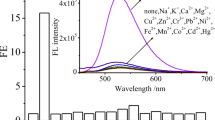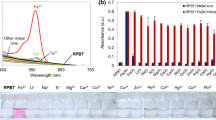Abstract
A fluorescent sensor based on 1,2,1ʹ,2ʹ- Tetra(methoxycarbonyl)- 3,3ʹ- bis(p-methylbenzoyl)- 7,7ʹ-bisindolizine (MBI) showing excellent selectivity towards Fe3+ ions was developed. Under optimized experimental conditions, the fluorescence intensity of 1,2,1ʹ,2ʹ- Tetramethoxycarbonyl- 3,3ʹ- bis(p-methylbenzoyl)- 7,7ʹ-bisindolizine was quenched linearly by Fe3+ ions in the range of 2.00 × 10−2 to 4.76 × 10−3 M. The limit of detection was found to be 3.17 × 10−3 M. The mechanism for quenching was investigated. The developed sensor was applied for the determination of Fe3+ in pharmaceutical samples.


Similar content being viewed by others
References
James PS, Raoul K (2005) Alexa Fluor 488 as an iron sensing molecule and its application in PEBBLE nanosensors. Analyst 130:528–533
Lizhu Z, Jingyum W, Jiangli F, Kexing G, Xiaojun P (2011) A highly selective fluorescent chemosensor for bioimaging of Fe3+. Bioorg. Med Chem Lett 21:5413–5416
Que EL, Domaille DW, Chang CJ (2008) Metals in neurobiology: probing their chemistry and biology with molecular imaging. Chem Rev 108:1517–1549
Annie HJ, Chang HC, Su WT (2012) DOPA-mediated reduction allows the facile synthesis of fluorescent gold nanoclusters for use as sensing probes for ferric ions. Anal Chem 84:3246–3253
Wang B, Hai J, Liu ZC, Wang Q, Yang ZY, Sun SH (2010) Selective detection of iron (III) by rhodamine-modified Fe3O4 nanoparticles. Angew Chem Int Ed 49:4576–4579
Ajlec R, Stupar J (1989) Determination of iron species in wine by ion-exchange chromatography–flame atomic absorption spectrometry. Analyst 114:137–142
Favaron R, Aleixo LM (2000) Development of a voltammetric method for the determination of iron (III) in Zn-Fe alloy galvanic baths. Fresenius J Anal Chem 368:611–615
Van den Berg CMG (2006) Chemical speciation of iron in seawater by cathodic stripping voltammetry with dihydroxynaphthalene. Anal Chem 78:156–163
Luan F, Burgos WD (2012) Sequential extraction method for determination of Fe (II/III) and U (IV/VI) in suspensions of iron-bearing phyllosilicates and uranium. Environ Sci Technol 46:11995–12002
Tarafder PK, Thakur R (2005) Surfactant-mediated extraction of iron and its spectrophotometric determination in rocks, minerals, soils, stream sediments and water samples. Microchem J 80:39–43
Abdel Azeem SM, Bader NR, Kuss HM, El-Shahat MF (2013) Determination of total iron in food samples after flow injection preconcentration on polyurethane foam functionalized with N,N-bis (salicylidene)-1,3-propanediamine. Food Chem 138:1641–1647
Bowie AR, Achterberg EP, Sedwick P, Ussher S, Worsfold PJ (2002) Real-time monitoring of picomolar concentrations of iron (II) in marine waters using automated flow injection-chemiluminescence instrumentation. Environ Sci Technol 36:4600–4607
Croot PL, Laan P (2002) Metal ions in biological systems. Anal Chim Acta 466:261–273
Rodrigues SSM, Lima AS, Teixeira LSG, Korn MDA, Santos JLM (2014) Determination of iron in biodiesel based on fluorescence quenching of CdTe quantum dots. Fuel 117:520–527
Du YY, Chen M, Zhang YX, Luo F, He CY, Li MJ, Chen X (2013) Determination of iron (III) based on the fluorescence quenching of rhodamine B derivative. Talanta 106:261–265
Dwivedi AK, Saikia G, Iyer PK (2011) Aqueous polyfluorene probe for the detection and estimation of Fe3+ and inorganic phosphate in blood serum. J Mater Chem 21:2502–2507
Chen X, Pradhan T, Wang F, Kim JS, Yoon J (2012) Fluorescent chemosensors based on spiroring-opening of xathenes and related derivatives. Chem Rev 112:1910–1956
Hong Y, Lam JWY, Tang BZ (2011) Aggregation-induced emission. Chem Soc Rev 40:5361–5388
Yang Y, Zhao Q, Feng W, Li F (2013) Luminescent chemodosimeters for bioimaging. Chem Rev 113:192–270
Divya T, Laina L, Leena R, Soumya TC, Girish KG (2013) Quantum dots based fluorescence sensorfor the selective determination of nimesulide. J Fluoresc 23:473–478
Malonne H, Hanuise J, Fontaine J (1998) Topical anti-inflammatory activity of new 2-(1-indolizinyl) propionic acid derivatives in mice. Pharm Pharmacol Commun 4:241–243
Medda S, Jaisankar P, Manna RK, Pal B, Giri VS, Basu MK (2003) Phospholipid microspheres: a novel delivery mode for targeting antileishmanial agent in experimental leishmaniasis. J Drug Target 11:123–128
Campagna F, Carotti A, Casini G, Macripo M (1990) Synthesis of new heterocyclic ring systems: indeno [2,1-b] benzo [g] indolizine and indeno [1′,2′:5,4]pyrrolo[2,1-a]phthalazine. Heterocycles 31:97–107
Olden K, Breton P, Grzegorzevski K, Yasuda Y, Gause BL, Creaipe OA, Newton SA, White SL (1991) The potential importance of swainsonine in therapy for cancers and immunology. Pharmacol Ther 50:285–290
Saeva FD, Luss HR (1988) Novel synthesis of the 2, 3-benzindolizine ring system. Mechanism of formation, redox, electronic absorption and fluorescence behaviour. J Org Chem. 53:1804–1806
Delattre F, Woisel P, Surpateanu G, Cazier F, Blach P (2005) 1-(4-nitrophenoxycarbonyl)-7-pyridin-4-yl indolizine: a new versatile fluorescent building block. Application to the Synthesis of a Series of Fluorescent β-Cyclodextrins. Tetrahedron 61:3939–3945
Gopal MS, Anitha I (2014) Aqueous phase microwave synthesis of some bisindolizines. Int J Chem Stud 2:35–38
Wen G, Zhu M, Wang Z, Meng X, Hu H, Guo Q (2006) Fluorescence enhancement of polyamine derivatives of 1,8-naphthalimide with transition metal ions. Chin J Chem Phys 19:506–510
Chen Y, Rosenzweig Z (2002) Luminescent CdS quantum dots as selective ion probes. Anal Chem 74:5132–5138
Cai ZX, H Y, Y Z, XP Y (2006) Preparation, characterization and evaluation of water-soluble L-cysteine-capped-CdS nanoparticles as fluorescence probe for detection of Hg(II) in aqueous solution. Anal Chim Acta 559:234–239
Chen B, Yu Y, Zhou ZT, Zhong P (2004) Synthesis of novel nanocrystals as fluorescent sensors for Hg2+ ions. Chem Lett 33:1608–1609
Vlahovici A, Druta I, Andrei M, Cotlet M, Dinica R (1999) Photophysics of some indolizines, derivatives from bipyridyl, in various media. J Lumin 82:155–162
Skoog and West, Fundamentals of Analytical Chemistry, 2nd Ed., Chapter 29.
Vogel, A Textbook of Quantitative Inorganic Analysis, 3rd Ed., p. 294, 310 and 787.
Acknowledgments
One of the authors (Sheela Gopal M) is thankful to the University Grants Commission (UGC), India, for granting FIP and Department of Applied Chemistry CUSAT, Cochin for their technical support. The author Divya Thomas express the gratitude to Council of Scientific and Industrial Research (CSIR) for the award of research fellowship.
Author information
Authors and Affiliations
Corresponding author
Ethics declarations
Conflict of Interest
The authors declared that there is no conflict of interest regarding the publication of this paper.
Rights and permissions
About this article
Cite this article
I, A., M, S.G. & Thomas, D. A New Fluorescent Sensor Based on Bisindolizine Derivative. J Fluoresc 26, 725–729 (2016). https://doi.org/10.1007/s10895-015-1760-5
Received:
Accepted:
Published:
Issue Date:
DOI: https://doi.org/10.1007/s10895-015-1760-5




